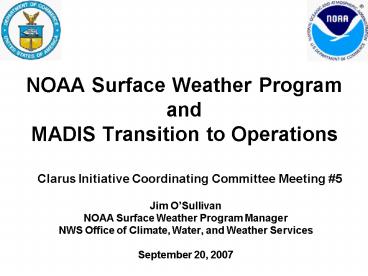NOAA Surface Weather Program and MADIS Transition to Operations PowerPoint PPT Presentation
1 / 14
Title: NOAA Surface Weather Program and MADIS Transition to Operations
1
NOAA Surface Weather Program and MADIS
Transition to Operations
Clarus Initiative Coordinating Committee Meeting
5
- Jim OSullivan
- NOAA Surface Weather Program Manager
- NWS Office of Climate, Water, and Weather
Services - September 20, 2007
2
The NOAA Big Picture
NOAA Headquarters
National Environmental Satellite, Data and
Information
National Marine Fisheries Service
Oceanic and Atmospheric Research
National Ocean Service
National Weather Service
NOAA Marine and Aviation Operations
Program Planning and Integration
Ecosystem Goal Team
Climate Goal Team
Weather and Water Goal Team
Commerce and Transportation Goal Team
3
Commerce and TransportationOverview
- Surface Weather
- Aviation Weather
- Marine Weather
- Marine Transportation System
- Geodesy
- Emergency Response
4
Commerce and Transportation Key Strategies
Information that Moves America
- NOAA has enhanced the American Publics ability
to - Know where they are
- Get where they are going safely and efficiently
- Make appropriate decisions for a safe, secure,
efficient, and environmentally sound
transportation network. - NOAAs essential services are uninterrupted and
available during emergencies and critical events
5
NOAAs Surface Weather Program
- NOAA is responsible for protecting life and
property and promoting safe and efficient
commerce and transportation - Weather contributes to over 7,400 fatalities,
over 600,000 injuries, and 1,400,000
weather-related - highway crashes per year
- Representing the needs of all surface
transportation sectors, i.e., roadways, rail,
transit and pipeline operations - Opportunity to improve safety
- with timely weather information
- that is transportation-relevant
Annual weather averages for the years 1997-2006
adverse road conditions from 1996-2005.
Compiled from Storm Data, NWS and NCDC and the
DOT Fatality Analysis Reporting System
6
Surface Weather within NOAAs Commerce
Transportation Goal
- Meteorological Assimilation Data Ingest System
(MADIS) Transition to Operations - National Surface Weather Observing System (NSWOS)
- Within the NWS Telecommunications Gateway (NWSTG)
- Integration with DOTs Clarus Initiative
- MADIS transition is key to providing data
management support for NOAA/CT and NWS mission - Integration of other NOAA and non-NOAA networks
- NOAA essential services and customer requirements
7
Snapshot of Observations
8
NOAAs Surface Observations Requirements
- Maintaining and enhancing NOAAs observing
systems as well as leveraging existing and
emerging partner and citizen platforms are
necessary to address all requirements NOAA has
for observations - NOAA service requirements for observations are
composed primarily around three elements - Required accuracy
- Station density
- Reporting interval
- Metadata increased awareness and importance
9
MADIS An Overview
- Developed by NOAA Researchs Earth System
Research Laboratorys Global Systems Division
(formerly FSL) - Data management system thats flexible,
expandable and interoperable an architecture
for the future - Provides government and non-government mesonet,
upper-air, and coastal data to NOAA and the
enterprise - Data are stratified and informed by metadata
- Transitioning MADIS to NWS operations will
provide 24x7 maintenance support with offsite
system backup - Leverages NOAAs extensive data management
infrastructure and investment
10
MADIS Data Sources and Outputs
11
The MADIS Difference
12
MADIS Activities
- 1st part of risk reduction complete
- Proving blade concept could fit into operational
concept - 2nd part of risk reduction being completed
- Virtualize part of current MADIS code
- Complete a thread of data to obtain same output
as ESRL - Draft System Requirement Specifications and
Functional Requirements Document - Completing briefs CIO management
- NWSTC under CIO office
- Core Design Team
13
Conclusions
- NOAA Surface Weather Program
- Priority is obtaining quality observations
- Work with private and public weather and
transportation partners - MADIS transition to NWS operstions key to meet
NOAA essential services needs and customer needs
14
NOAA Surface Weather Program
For questions or comments, contact Jim
OSullivan Jim.OSullivan_at_noaa.gov (301)
713-1792 x121

